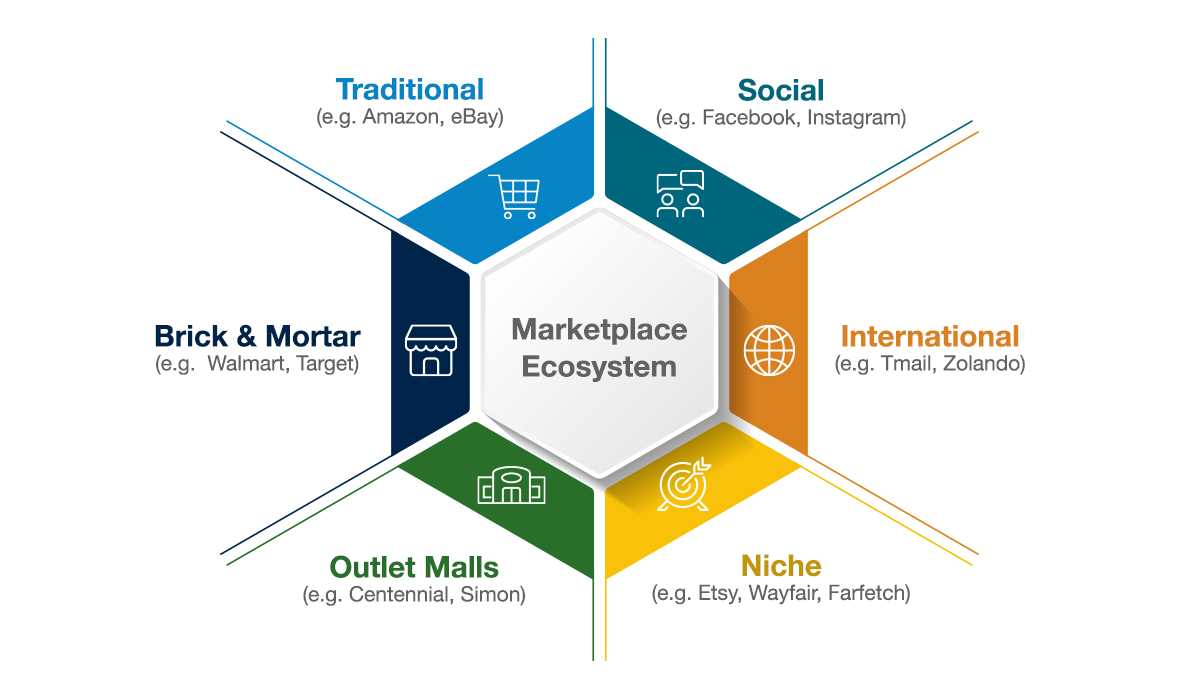The Death And Rebirth Of Retail (As We Will Know It!)
From humble beginnings as an online bookstore, Amazon, today is a dominant global force. In 2020, Amazon’s marketplace is expected to generate ~$480 billion in Gross Merchandise Value globally of which $267 billion is in the U.S. (up 49 percent vs. the prior year).[1] To put that in context, for every dollar spent on online marketplaces in U.S., ~70 cents are spent on Amazon. The pandemic has accelerated retail e-commerce by an estimated five to ten years, with growth across all sectors. According to the National Retail Federation, consumers spent $211.5 billion online during the second quarter (shortly after COVID-19), up 45 percent from last year. With COVID-19, typical consumer behaviors and preferences are being altered as well; e.g., 60 percent of boomers are utilizing Amazon Prime, Shipt and other delivery services more often now, specifically because of COVID-19.[2] Going into Black Friday weekend, Target’s online sales were up more than 150 percent versus last year, and Walmart’s online sales were up 120 percent.[3] These are impressive numbers for ‘The rebirth of retail’.
The rebirth of retail (as we will know it!)
So what is next? Seismic shifts in the online marketplace ecosystem pave the way for next evolution—the rebirth of retail. There are three seismic shifts at play and these are closer than many realize. These shifts will fundamentally reshape how retail and other consumer-facing companies go to market:
- Expanding physical dominance of key marketplace players: Through the opportunities created with COVID-19, Amazon will further expand its physical footprint either through acquisition or partnerships with brick and mortar retailers. We need not look far to see how Amazon has transformed its overall value proposition with Whole Foods. Its next target could be one (or even two) of the struggling retailers like Macy’s, Kohl’s or Sears.
- The new normal, same-day delivery beyond grocery: Many large marketplace players are piloting and testing this capability right now and it’s hard to believe that it was only in 2002 that Amazon launched the free super saver delivery program. With Walmart’s and Target Plus’s own versions of Prime, it’s only a matter of time in 2021 that consumers can have a full basket of products delivered to their doorstep in a matter of hours. In 2020, we started seeing pieces of this coming to life (e.g., Best Buy and Instacart partnership for same-day home delivery).
- Increased bundling of services with goods: Services penetration online has traditionally lagged goods given the lack of homogeneity with services but this is fast changing with COVID-19. For example, Uber launched Uber Eats to compete with DoorDash, and during the latest quarterly earnings was the one bright spot as consumer travel lowered significantly due to the pandemic. Similarly, DoorDash which started as food delivery, has moved into grocery and pharmacy delivery after tie-ups with Smart & Final and Walgreens, competing directly with Instacart.
The opportunity at stake: $4.2–4.9 trillion by 2023[4]
These seismic shifts create new opportunities and challenges for consumer-facing industries and retailers. As foot traffic continues to be low, buying preferences shift online and spending continues to be below historical levels, consumer-facing industries and retailers are looking for new avenues to drive growth. Today there are 125+ marketplaces (excluding services) with more than 1 million site visits a month (~50 in the U.S.).[5] How does one effectively navigate the myriad of complex marketplace ecosystems to choose from?

Putting this to action (mid- to longer-term focus)
In order to capitalize on this opportunity, we believe that executives need to focus on four core areas:
Reevaluate the role of marketplaces in overall company strategy
Gone are the days where online marketplaces can be tucked under your direct to consumer or e-commerce business. Companies need to start looking at marketplaces as a standalone channel and define the role of this channel within the overall company strategy. For example, a large national U.S. retailer repivoted its strategy and is reducing its store footprint by ~80 percent over the next three years while setting up marketplaces as an independent channel. This has enabled it to better serve evolving customer needs while significantly reducing its rent liability.
Identify the marketplaces that are best suited to your brand and product positioning
In this large national retailer example, it operates in a commoditized category with price and convenience as top priorities for its customers. It made sense for the retailer to partner with the traditional and brick and mortal marketplaces as outlined in Exhibit 1. It is imperative to evaluate the myriad of marketplace options through a multidimensional lens (e.g., consumer base, category penetration, AUR and who owns the customer) to identify the marketplaces best suited for your brand. For a premium apparel retailer we worked with, the traditional and brick and mortar marketplaces did not align with the target customer, product position or AUR. As part of the retailer’s strategy repivot, one of the things it did was to lean heavily toward appropriate niche marketplaces where it had better control of how the brand showed up vs. being another shirt in a big marketplace.
Define what price point to compete at, and with what assortment on what marketplaces
It’s to be seen how brands like Oscar de la Renta, Roland Mouret and La Perla perform on the Amazon Luxury stores. The price point on each marketplace by category varies a lot; e.g., AUR for men’s pullovers on one of the largest marketplaces is $35 while it is 28 percent lower on another competitor’s marketplace. It is imperative that companies take a merchandizing-driven view across all channels to define what assortments should be put on marketplace channels and then identify the target marketplaces and price points to compete at. For a large global lifestyle apparel retailer we worked with, the retailer created a new mass market line for a traditional marketplace in order to protect its flagship brand while still competing at a price point relevant for that marketplace.
Build the optimal operating model
There are a plethora of partners and tools that thrive off the online marketplaces, all the way from marketing specialists and content writers to supply chain partners. In our experience there are specific activities that are more conducive to being performed in-house and others for which having the right partners can be the difference between winning and losing. As an example, for a consumer packaged client of ours, we helped it assess and select a marketing optimization firm that leverages AI and data analytics to automate allocation of marketing dollars and maximize return on investments.
Putting this to action (short-term)
As companies think about the right strategy for midterm to longer-term, there are a series of short-term, low-cost investment actions that can be taken coming out of the holidays, e.g.:
- Opportunistically (for at least core SKUs) improve how your brands show up on marketplaces; e.g., with a video about your brand story or product usage
- Pilot AI-based marketing spend optimization tools to automate bid optimization, targeting and budget allocation
- Set up marketplace technology integration platforms (e.g., CommerceHub, ChannelAdvisor) that can plug and play into multiple marketplaces in an accelerated timeframe
At A&M, we are prepared to assist and be a steady partner for you during these rough times. We are passionate about helping companies achieve their maximum potential and be on the right side of disruption. Reach out to our team today.
[1] Cowen Equity research
[2] Nkongho Beteck, National Retail Federation (August 18, 2020)
[3] Retaildive.com, Winners and losers of Black Friday 2020 (November 28, 2020)
[4] Webretailer.com
[5] A&M estimates 20–25 percent YoY growth over 2019 online market sales of ~$2 trillion.

